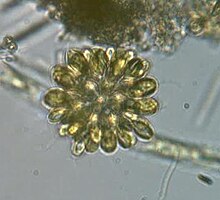Synurid
| Synurids | |
|---|---|

| |
| A colony of Synura sp. | |
| Scientific classification | |
| Domain: | Eukaryota |
| Clade: | Diaphoretickes |
| Clade: | SAR |
| Clade: | Stramenopiles |
| Phylum: | Gyrista |
| Subphylum: | Ochrophytina |
| Class: | Chrysophyceae |
| Order: | Synurales Andersen, 1987 |
| Genera[1] | |
The synurids (order Synurales) are a small group of heterokont algae, found mostly in freshwater environments, characterized by cells covered in silica scales.[2]
Characteristics[edit]

They are covered in silicate scales and spines. In Synura, these are formed on the surface of the chloroplasts,[3] two of which are usually present, but sometimes only one divided into two lobes is seen. The cells have two heterokont flagella, inserted parallel to one another at the anterior, whose ultrastructure is a distinguishing characteristic of the group. Both asexual and isogamous sexual reproduction occur.
Classification[edit]
Synurales are divided into three families, each with one genus:[4]
- Family Mallomonadaceae Diesing, 1866
- Mallomonas Perty, 1852
- Family Synuraceae Lemmermann, 1899 emend. B.Y. Jo, J.I. Kim, W. Shin, P.Škaloud & P. Siver, 2016
- Synura Ehrenberg, 1834
- Family Neotessellaceae B.Y. Jo, J.I. Kim, W. Shin, P.Škaloud & P. Siver, 2016
- Neotessella B.Y. Jo, J.I. Kim, W. Shin, P.Škaloud & P. Siver, 2016 (=Tessella Playfair, 1915 nom. illeg.)
History[edit]
The genus Synura was proposed in 1834 by the German microscopist Christian Gottfried Ehrenberg (1795–1876).[5]
The synurids were originally included among the golden algae in the order Ochromonadales as the family Mallomonadaceae or as the family Synuraceae . They were formally defined as a separate group by Andersen in 1987, who placed them in their own class Synurophyceae, based on an earlier approach of more narrowly defining major lineages of chrysophyte algae by British phycologist David Hibberd.[6][7]
The Chrysophyceae and Synurophyceae are currently recognized as closely related taxa within the Stramenopiles.[8][9] Present classifications include the synurids as an order (Synurales) within Chrysophyceae.[2][10]
References[edit]
- ^ Škaloud, Pavel; Kristiansen, Jørgen; Škaloudová, Magda (July 2013). "Developments in the taxonomy of silica-scaled chrysophytes – from morphological and ultrastructural to molecular approaches". Nordic Journal of Botany. 31 (4) (published August 2013): 385–402. doi:10.1111/j.1756-1051.2013.00119.x.
- ^ a b Škaloud P, Škaloudová M, Procházková A, Němcová Y (2014). "Morphological delineation and distribution patterns of four newly described species within the Synura petersenii species complex (Chrysophyceae, Stramenopiles)". European Journal of Phycology. 49 (2): 213–229. Bibcode:2014EJPhy..49..213S. doi:10.1080/09670262.2014.905710.
- ^ Barry S.C. Leadbeater (1990), "Ultrastructure and assembly of the scale case in Synura (Synurophyceae Andersen)", British Phycological Journal, 25 (2): 117–132, doi:10.1080/00071619000650111
- ^ Bok Yeon Jo; Jong Im Kim; Pavel Škaloud; Peter A. Siver; Woongghi Shin (1 September 2016). "Multigene phylogeny of Synura (Synurophyceae) and descriptions of four new species based on morphological and DNA evidence". European Journal of Phycology. 51 (4): 413–430. doi:10.1080/09670262.2016.1201700. ISSN 0967-0262. Wikidata Q99647124.
- ^ See:
- Ehrenberg (1833). "Dritter Beitrag zur Erkenntniss grosser Organisation in der Richtung des kleinsten Raumes" [Third contribution to [our] knowledge of greater organization in the direction of the smallest realm]. Abhandlungen der Königlichen Akademie der Wissenschaften zu Berlin [Treatises of the Royal Academy of Sciences in Berlin] (in German). 1833: 145–336. From p. 281: Ehrenberg created a new family, Volvocina, " ... wozu ich die vier neuen Gattungen Chlamidomonas, Syncrypta, Synura, und Uroglena stelle." ( ... into which I place the four new genera Chlamidomonas, Syncrypta, Synura, and Uroglena.) [Note: According to p. 145, Ehrenberg's paper was first presented in 1832, revised somewhat, and published in 1834.]
- See also: AlgaeBase: Synura Ehrenberg, 1834
- ^ Hibberd, D. J. (1976). "The ultrastructure and taxonomy of the Chrysophyceae and Prymnesiophyceae (Haptophyceae): A survey with some new observations on the ultrastructure of the Chrysophyceae". Botanical Journal of the Linnean Society. 72 (2): 55–80. doi:10.1111/j.1095-8339.1976.tb01352.x.
- ^ Hibberd, David J. (1979). "The structure and phylogenetic significance of the flagellar transition region in the chlorophyll c-containing algae". Biosystems. 11 (4): 243–261. Bibcode:1979BiSys..11..243H. doi:10.1016/0303-2647(79)90025-X. PMID 396946.
- ^ Grant J, Tekle YI, Anderson OR, Patterson DJ, Katz LA (March 2009). "Multigene Evidence for the Placement of a Heterotrophic Amoeboid Lineage Leukarachnion sp. among Photosynthetic Stramenopiles". Protist. 160 (3): 376–85. doi:10.1016/j.protis.2009.01.001. PMID 19282238.
- ^ W. Vyverman; G. Cronberg (March 1993). "Scale bearing chrysophytes from Papua New Guinea". Nordic Journal of Botany. 13 (1): 111–20. doi:10.1111/j.1756-1051.1993.tb00022.x.
- ^ Cavalier-Smith, Thomas (2017). "Kingdom Chromista and its eight phyla: a new synthesis emphasising periplastid protein targeting, cytoskeletal and periplastid evolution, and ancient divergences". Protoplasma. 255 (1): 297–357. doi:10.1007/s00709-017-1147-3. PMC 5756292. PMID 28875267.
External links[edit]
